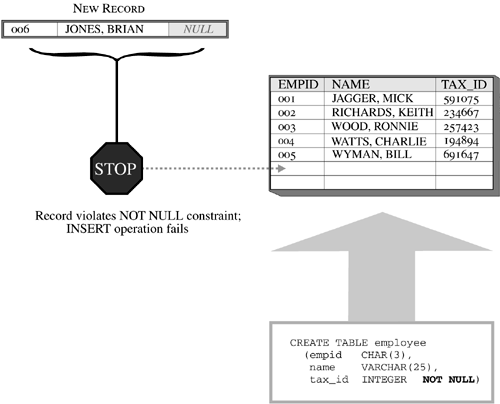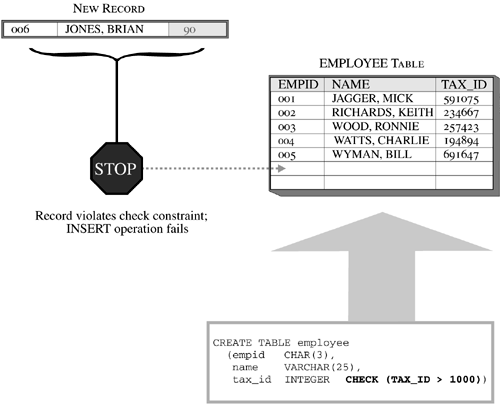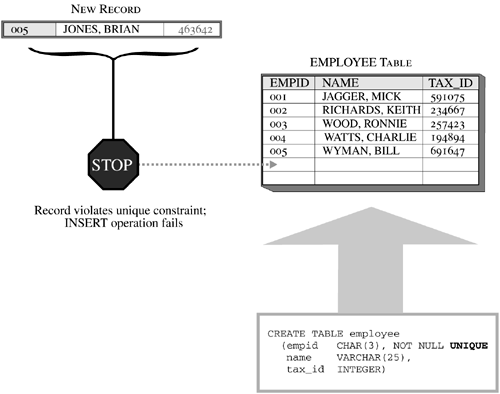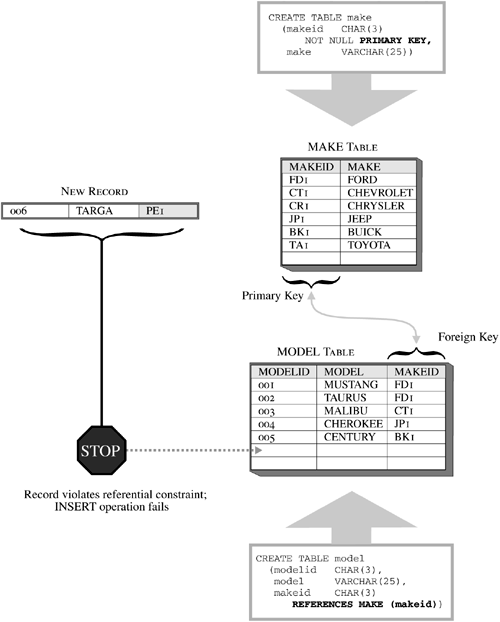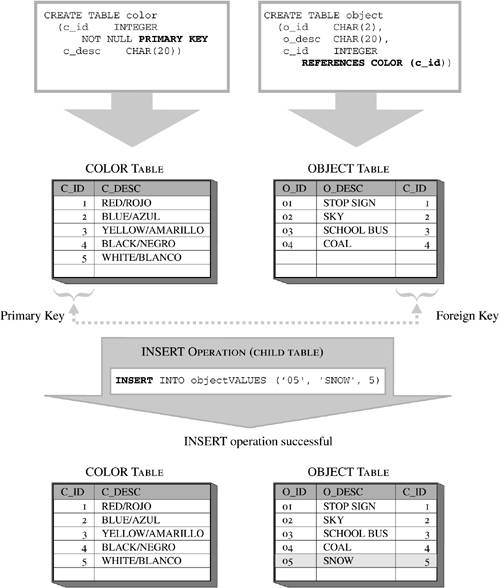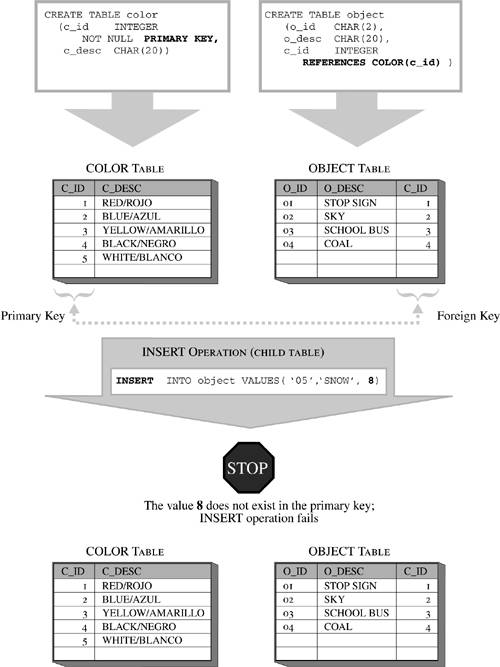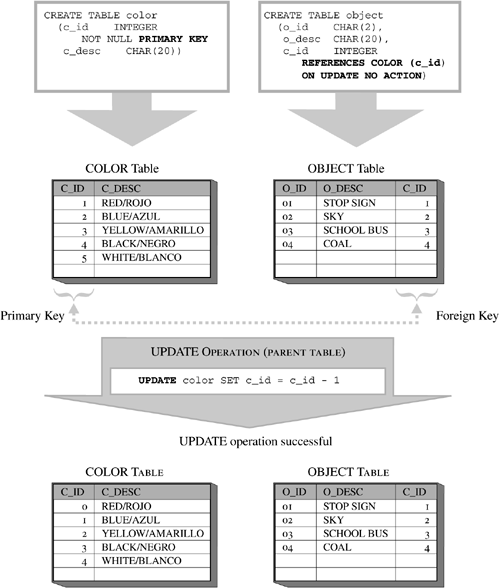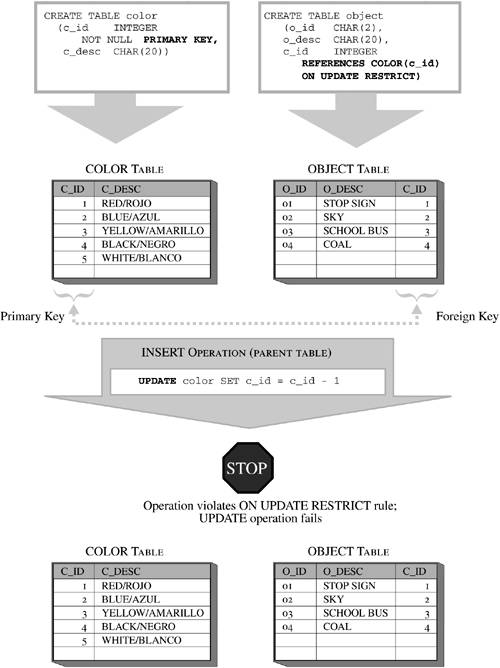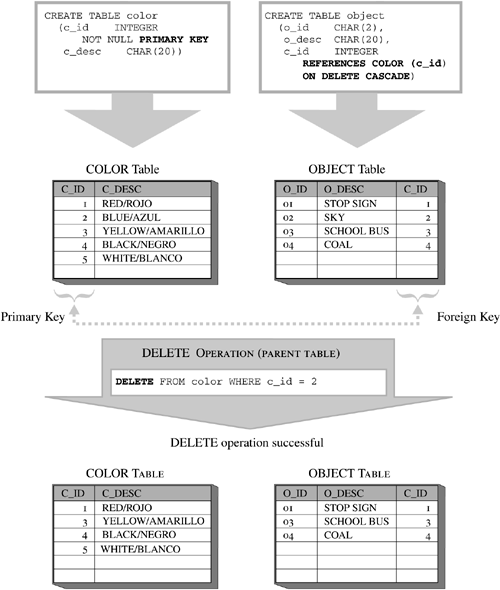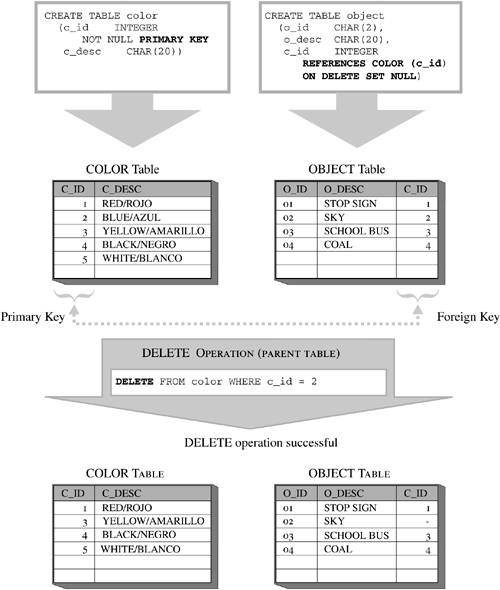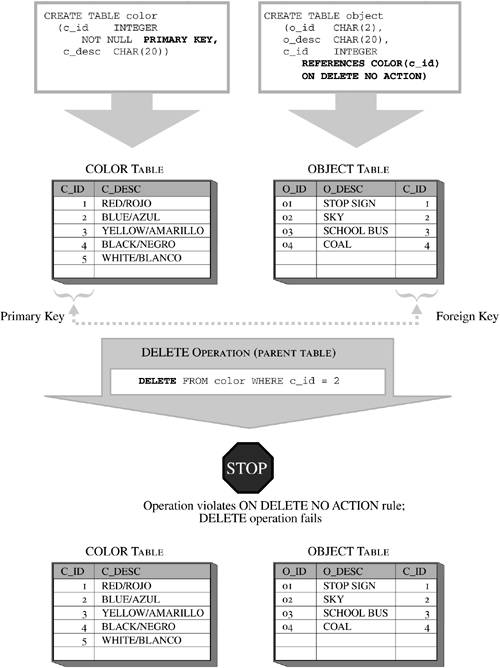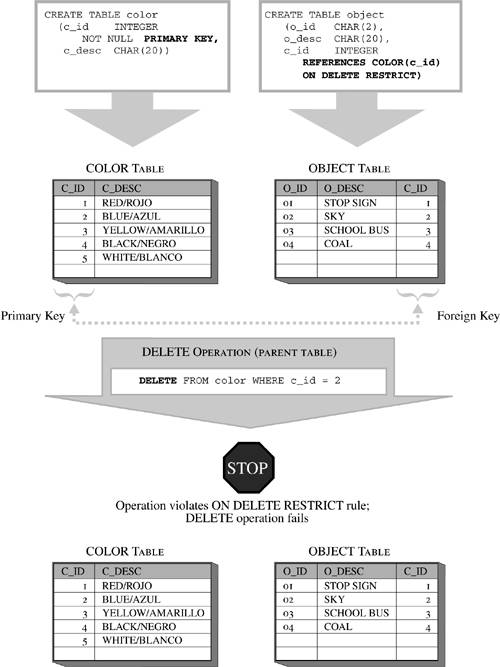Understanding Constraints
| Within most businesses, data often must adhere to a certain set of rules and restrictions. For example, companies typically have a specific format and numbering sequence they use when generating purchase orders. Like triggers, constraints allow you to place the logic needed to enforce such business rules directly in the database rather than in applications that work with the database. Essentially, triggers are sets of actions that are to be executed whenever an insert, update, or delete operation is performed on a specific table. Constraints, on the other hand, are rules that govern how data values can be added to a table, as well as how those values can be modified once they have been added. The following types of constraints are available:
Constraints are usually defined during table creation; however, constraints can also be added to existing tables using the ALTER TABLE SQL statement. (For more information, refer to Chapter 5, "Working with DB2 UDB Data.") NOT NULL ConstraintsWith DB2 UDB, null values (not to be confused with empty strings) are used to represent missing or unknown data and/or states. And by default, every column in a table will accept a null value. This allows you to add records to a table when not all of the values that pertain to the record are known. However, there may be times when this behavior is unacceptable (for example, a tax identification number might be required for every employee that works for a company). When such a situation arises, the NOT NULL constraint can be used to ensure that a particular column in a base table is never assigned a null value; once the NOT NULL constraint has been defined for a column, any operation that attempts to place a null value in that column will fail. Figure 6-1 illustrates how the NOT NULL constraint is used. Figure 6-1. How the NOT NULL constraint prevents null values. Because NOT NULL constraints are associated with a specific column in a base table, they are usually defined during the table creation process. Default ConstraintsJust as there are times when it is objectionable to accept a null value, there may be times when it is desirable to have the system provide a specific value for you (for example, you might want to automatically assign the current date to a particular column whenever a new record is added to a table). In these situations, the default constraint can be used to ensure that a particular column in a base table is assigned a predefined value (unless that value is overridden) each time a record is added to the table. The predefined value provided could be null (if the NOT NULL constraint has not been defined for the column), a user -supplied value compatible with the column's data type, or a value furnished by the DB2 Database Manager. Table 6-2 shows the default values that can be provided by the DB2 Database Manager for the various DB2 UDB data types available. Table 6-2. DB2 Database Manager-Supplied Default Values
Figure 6-2 illustrates how the default constraint is used. Figure 6-2. How the default constraint is used to provide data values. Like NOT NULL constraints, default constraints are associated with a specific column in a base table and are usually defined during the table creation process. Check ConstraintsSometimes, it is desirable to control what values will be accepted for a particular item and what values will not (for example, a company might decide that all nonexempt employees must be paid, at a minimum, the federal minimum wage). When this is the case, the logic needed to determine whether a value is acceptable can be incorporated directly into the data entry program being used to collect the data. A better way to achieve the same objective is by defining a check constraint for the column in the base table that is to receive the data value. A check constraint (also known as a table check constraint ) can be used to ensure that a particular column in a base table is never assigned an unacceptable value ”once a check constraint has been defined for a column, any operation that attempts to place a value in that column that does not meet specific criteria will fail. Check constraints are comprised of one or more predicates (which are connected by the keywords AND or OR) that collectively are known as the check condition. This check condition is then compared with the data value provided and the result of this comparison is returned as the value "TRUE", "FALSE", or "Unknown". If the check constraint returns the value "TRUE", the value is acceptable, so it is added to the database. If, on the other hand, the check constraint returns the value "FALSE" or "Unknown", the operation attempting to place the value in the database fails, and all changes made by that operation are backed out of the database. However, it is important to note that when the results of a particular operation are rolled back because of a check constraint violation, the transaction that invoked that operation is not terminated , and other operations within that transaction are unaffected. Figure 6-3 illustrates how a simple check constraint is used. Figure 6-3. How a check constraint is used to control what values are accepted by a column. Like NOT NULL constraints and default constraints, check constraints are associated with a specific column in a base table and are usually defined during the table creation process. Unique ConstraintsBy default, records that are added to a base table can have the same values assigned to any of the columns available any number of times. As long as the records stored in the table do not contain information that should not be duplicated , this kind of behavior is acceptable. However, there are times when certain pieces of information that make up a record should be unique (for example, if an employee identification number is assigned to each individual that works for a particular company, each number used should be unique ”two employees should never be assigned the same employee identification number). In these situations, the unique constraint can be used to ensure that the value(s) assigned to one or more columns when a record is added to a base table are always unique; once a unique constraint has been defined for one or more columns, any operation that attempts to place duplicate values in those columns will fail. Figure 6-4 illustrates how the unique constraint is used. Figure 6-4. How the unique constraint prevents the duplication of data values. Unlike NOT NULL constraints, default constraints, and check constraints, which are only associated with single columns in a base table, unique constraints can be associated with an individual column or with a group of columns. However, like the other constraints, unique constraints are usually defined during the table creation process. Regardless of when a unique constraint is defined, when it is created the DB2 Database Manager looks to see if an index for the columns the unique constraint refers to already exists. If so, that index is marked as being unique and system-required. If not, an appropriate index is created and marked as being unique and system-required. This index is then used to enforce uniqueness whenever new records are added to the column(s) the unique constraint was defined for.
A primary key, which we will look at next , is a special form of unique constraint. Only one primary key is allowed per table, and every column that is used to define a primary key must be assigned the NOT NULL constraint. In addition to ensuring that every record added to a table has some unique characteristic, primary keys allow tables to participate in referential constraints. A table can have any number of unique constraints; however, a table cannot have more than one unique constraint defined on the same set of columns. And because unique constraints are enforced by indexes, all the limitations that apply to indexes (for example, a maximum of 16 columns with a combined length of 255 bytes is allowed; none of the columns used can have a large object or long character string data type, etc.) apply to unique constraints. Referential Integrity ConstraintsIf you've had the opportunity to design a database in the past, you are probably aware that data normalization is a technique used to ensure that there is only one way to get to a fact stored in a database. Data normalization is possible because two or more individual base tables can have some type of relationship with one another, and information stored in related base tables can be combined if necessary, using a join operation. Data normalization is also where referential integrity constraints come into play; referential integrity constraints (also known as referential constraints and foreign key constraints) are used to define required relationships between two base tables. To understand how referential constraints work, it helps to look at an example. Suppose you own a small auto parts store, and you use a database to keep track of the inventory you have on hand. Many of the parts you stock will only work with a particular "make" and "model" of an automobile; therefore, your database has one table named MAKE to hold make information and another table named MODEL to hold model information. Since these two tables are related (every model must belong to a make), a referential constraint can be used to ensure that every record that is stored in the MODEL table has a corresponding record in the MAKE table; the relationship between these two tables is established by comparing values that are to be added to the "MAKE" column of the MODEL table (known as the foreign key of the child table ) with the values that currently exist for the set of columns that make up the primary key of the MAKE table (known as the parent key of the parent table ). To create the referential constraint just described, you would define a primary key, using one or more columns in the MAKE table, and you would define a foreign key for one or more corresponding columns in the MODEL table that reference the MAKE table's primary key. Assuming a column named MAKEID is used to create the primary key for the MAKE table and a column also named MAKEID is used to create the foreign key for the MODEL table, the referential constraint created would look something like the one shown in Figure 6-5. Figure 6-5. How a referential constraint is used to define a relationship between two tables. In this example, a single column is used to define the parent key and the foreign key of the referential constraint. However, as with unique constraints, multiple columns can be used to define the parent key and the foreign key of a referential constraint.
As you can see, referential constraints are more complex than NOT NULL constraints, default constraints, check constraints, and unique constraints. In fact, they can be so complex that a set of special terms are used to identify the individual components that can make up a single referential constraint. You may already be familiar with some of them; the complete list of terms used can be seen in Table 6-3. The primary reason referential constraints are created is to guarantee that data integrity is maintained whenever one table object references another. As long as a referential constraint is in effect, the DB2 Database Manager guarantees that, for every row in a child table that has a value in any column that is part of a foreign key, there is a corresponding row in the parent table. So what happens when an SQL operation attempts to manipulate data in a way that would violate a referential constraint? To answer this question, let's look at what could compromise data integrity if the checks and balances provided by a referential constraint were not in place: Table 6-3. DB2 UDB Referential Integrity Constraint Terminology
The DB2 Database Manager can either prohibit ("restrict") these types of operations from being performed on tables that are part of a referential constraint or it can attempt to carry out these actions in a way that will safeguard data integrity. In either case, DB2 UDB uses a set of rules to control the operation's behavior. Each referential constraint has its own set of rules (which consist of an Insert Rule, an Update Rule, and a Delete Rule), and the way a particular rule will function can be specified as part of the referential constraint creation process. The Insert Rule for referential constraintsThe Insert Rule guarantees that a value can never be inserted into the foreign key of a child table unless a matching value can be found in the corresponding parent key of the associated parent table. Any attempt to insert records into a child table that violates this rule will result in an error, and the insert operation will fail. In contrast, no checking is performed when records are added to the parent key of the parent table. The Insert Rule for a referential constraint is implicitly created when the referential constraint itself is created. Figure 6-6 illustrates how a row that conforms to the Insert Rule for a referential constraint is successfully added to a child table; Figure 6-7 illustrates how a row that violates the Insert Rule causes an insert operation to fail. Figure 6-6. An insert operation that conforms to the Insert Rule of a referential constraint. Figure 6-7. An insert operation that violates the Insert Rule of a referential constraint. It is important to note that because the Insert Rule exists, records must be inserted in the parent key of the parent table before corresponding records can be inserted into the child table. (Going back to our MAKE/MODEL example, this means that a record for a new MAKE must be added to the MAKE table before a record that references the new MAKE can be added to the MODEL table.) The Update Rule for referential constraintsThe Update Rule controls how update operations performed against either table (child or parent) participating in a referential constraint are to be processed . The following two types of behaviors are possible, depending upon how the Update Rule is defined:
Figure 6-8 illustrates how the Update Rule is enforced when the ON UPDATE NO ACTION definition is used; Figure 6-9 illustrates how the Update Rule is enforced when the ON UPDATE RESTRICT definition is used. Figure 6-8. How the ON UPDATE NO ACTION Update Rule of a referential constraint is enforced. Figure 6-9. How the ON UPDATE RESTRICT Update Rule of a referential constraint is enforced. Like the Insert Rule, the Update Rule for a referential constraint is implicitly created when the referential constraint itself is created. If no Update Rule definition is provided when the referential constraint is defined, the ON UPDATE NO ACTION definition is used as the default. Regardless of which form of the Update Rule is used, if the condition of the rule is not met, the update operation will fail, an error message will be displayed, and any changes made to the data in either table participating in the referential constraint will be backed out. The Delete Rule for referential constraintsThe Delete Rule controls how delete operations performed against the parent table of a referential constraint are to be processed. The following four types of behaviors are possible, depending upon how the Delete Rule is defined:
Figure 6-10 illustrates how the Delete Rule is enforced when the ON DELETE CASCADE definition is used; Figure 6-11 illustrates how the Delete Rule is enforced when the ON DELETE SET NULL definition is used; Figure 6-12 illustrates how the Delete Rule is enforced when the ON DELETE NO ACTION definition is used; and Figure 6-13 illustrates how the Delete Rule is enforced when the ON DELETE RESTRICT definition is used. Figure 6-10. How the ON DELETE CASCADE Delete Rule of a referential constraint is enforced. Figure 6-11. How the ON DELETE SET NULL Delete Rule of a referential constraint is enforced. Figure 6-12. How the ON DELETE NO ACTION Delete Rule of a referential constraint is enforced. Figure 6-13. How the ON DELETE RESTRICT Delete Rule of a referential constraint is enforced. Like the Insert Rule and the Update Rule, the Delete Rule for a referential constraint is implicitly created when the referential constraint itself is created. If no Delete Rule definition is provided when the referential constraint is defined, the ON DELETE NO ACTION definition is used as the default. No matter which form of the Delete Rule is used, if the condition of the rule is not met, an error message will be displayed, and the delete operation will fail. If the ON DELETE CASCADE Delete Rule is used and the deletion of a parent row in a parent table causes one or more dependent rows to be deleted from the corresponding child table, the delete operation is said to have been propagated to the child table. In such a situation, the child table is said to be delete-connected to the parent table. Because a delete-connected child table can also be the parent table in another referential constraint, a delete operation that is propagated to one child table can, in turn , be propagated to another child table, and so on. Thus, the deletion of one parent row from a single parent table can result in the deletion of several hundred rows from any number of tables, depending upon how tables are delete-connected. Therefore, the ON DELETE CASCADE Delete Rule should be used with extreme caution when a hierarchy of referential constraints permeates a database. Temporarily Suspending Constraint Checking with the SET INTEGRITY SQL StatementAlthough constraints provide a means of ensuring that some level of integrity is maintained as data is manipulated within a base table, their enforcement can prevent some types of operations from executing successfully. For example, suppose you want to bulk-load 10,000 rows of data into a base table using the LOAD utility. If the data that is to be loaded contains values that will violate a constraint defined for the table the data is to be loaded into, the load operation will fail. Or suppose you wish to add a new constraint to an existing table that already contains several hundred rows of data. If one or more rows in the table contain data values that violate the constraint you wish to add, any attempt to add the constraint will fail. In situations like these, it can be advantageous to suspend constraint checking just long enough to perform the desired operation. However when constraint checking is suspended , at some point it must be resumed, and at that time, rows in the table that cause a constraint to be violated must be located and dealt with. Constraint checking for a table can be suspended temporarily by executing the SET INTEGRITY SQL statement. When used to suspend constraint checking, the syntax for the simplest form of this statement is: SET INTEGRITY FOR [ TableName ,... ] OFF < AccessMode > where:
So if you wanted to temporarily suspend constraint checking for a table named EMPLOYEES and deny read-only access to that table while constraint checking is turned off, you could do so by executing a SET INTEGRITY statement that looks something like this: SET INTEGRITY FOR EMPLOYEES OFF When constraint checking is suspended for a particular table, that table is placed in "Check Pending" state to indicate that it contains data that has not been checked (and that may not be free of constraint violations). While a table is in "Check Pending"state, it cannot be used in insert, update, or delete operations, nor can it be used by any DB2 UDB utility that needs to perform these types of operations. In addition, indexes cannot be created for a table while it is in "Check Pending" state, and data stored in the table can be retrieved only if the access mode specified when the SET INTEGRITY statement was used to place the table in "Check Pending" state allows read-only access. Just as one form of the SET INTEGRITY statement is used to temporarily suspend constraint checking, another form is used to resume it. In this case, the syntax for the simplest form of the SET INTEGRITY statement is: [View full width]
or SET INTEGRITY FOR [[ TableName ] [ ConstraintType ] ,... ] IMMEDIATE UNCHECKED where:
Thus, if you wanted to resume constraint checking for the EMPLOYEES table that constraint checking was suspended for in the previous example, you could do so by executing a SET INTEGRITY statement that looks something like this: SET INTEGRITY FOR EMPLOYEES IMMEDIATE CHECKED When this particular form of the SET INTEGRITY statement is executed, the table named EMPLOYEES is taken out of the "Check Pending" state, and each row of data stored in the table is checked for constraint violations. If an offensive row is found, constraint checking is stopped , and the EMPLOYEES table is returned to the "Check Pending" state. However, if this form of the SET INTEGRITY statement is executed: SET INTEGRITY FOR EMPLOYEES IMMEDIATE CHECKED FOR EXCEPTION IN EMPLOYEES USE BAD_ROWS each row found that violates one or more of the constraints that have been defined for the EMPLOYEES table will be copied to a table named BAD_ROWS, where it can be corrected and copied back to the EMPLOYEES table if so desired. And finally, if this form of the SET INTEGRITY statement is executed: SET INTEGRITY FOR EMPLOYEES ALL IMMEDIATE UNCHECKED the table named EMPLOYEES is taken out of the "Check Pending" state, and no constraint checking is performed. However, this is a very hazardous thing to do and should only be done if you have some independent means of ensuring that the EMPLOYEES table does not contain data that violates one or more constraints defined. | ||||||||||||||||||||||||||||||||||||||||||||||||||||||||||||||||||||||||||||||||||
EAN: 2147483647
Pages: 68
